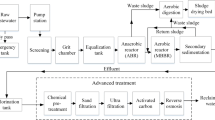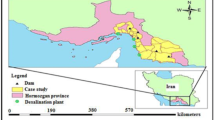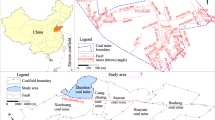Abstract
Without an engineering risk assessment for emergency disposal in response to sudden water pollution incidents, responders are prone to be challenged during emergency decision making. To address this gap, the concept and framework of emergency disposal engineering risks are reported in this paper. The proposed risk index system covers three stages consistent with the progress of an emergency disposal project. Fuzzy fault tree analysis (FFTA), a logical and diagrammatic method, was developed to evaluate the potential failure during the process of emergency disposal. The probability of basic events and their combination, which caused the failure of an emergency disposal project, were calculated based on the case of an emergency disposal project of an aniline pollution incident in the Zhuozhang River, Changzhi, China, in 2014. The critical events that can cause the occurrence of a top event (TE) were identified according to their contribution. Finally, advices on how to take measures using limited resources to prevent the failure of a TE are given according to the quantified results of risk magnitude. The proposed approach could be a potential useful safeguard for the implementation of an emergency disposal project during the process of emergency response.







Similar content being viewed by others

References
Akgün İ, Gümüşbuğa F, Tansel B (2015) Risk based facility location by using fault tree analysis in disaster management. Omega 52:168–179
Bedford T, Cooke R (2002) Probabilistic risk analysis : foundations and methods. J Am Stat Assoc 97:925–925
Bleed P, Watson D (1991) Frontier flintlocks: a fault tree analysis of firearm use at contact period sites of the great plains. Great Plains Res 1:233–248
Celik M, Lavasani SM, Wang J (2010) A risk-based modelling approach to enhance shipping accident investigation. Saf Sci 48:18–27
Chen SJ, Hwang CL (1992) Fuzzy multiple attribute decision making. Springer, Berlin Heidelberg, pp 289–486
China-EPA (2007) Practical handbook on environmental emergency response. China environmental science press, Environmental Inspection Office of Ministry, China
Clemons EK (1995) Using scenario analysis to manage the strategic risks of reengineering. Long Range Plan 28:123–123
Cooper WJ (2014) Responding to crisis: the West Virginia chemical spill. Environ Sci Technol 48:3095–3095
Ford DN, Sterman JD (1997) Expert knowledge elicitation to improve mental and formal models. Syst Dyn Rev 14:309–340
Fuller C (1999) The philosophy of risk. Secur J 12:75–76
Garvey PR (2009) Analytical methods for risk management. Crc Press, Boca Raton, pp 1–12
Han SH, Diekmann JE (2001) Approaches for making risk-based go/no-go decision for international projects. J Constr Eng Manag 127:300–308
Houben G, Lenie K, Vanhoof K (1999) A knowledge-based SWOT-analysis system as an instrument for strategic planning in small and medium sized enterprises. Decis Support Syst 26:125–135
Hyun KC, Min S, Choi H, Park J, Lee IM (2015) Risk analysis using fault-tree analysis (FTA) and analytic hierarchy process (AHP) applicable to shield TBM tunnels. Tunn Undergr Space Technol 49:121–129
Jiang J, Wang P, Lung WS, Guo L, Li M (2012) A GIS-based generic real-time risk assessment framework and decision tools for chemical spills in the river basin. J Hazard Mater 227-228:280–291
Kaplan S, Garrick BJ (1981) On the quantitative definition of risk. Risk Anal 1:11–27
Kececioglu D (1992) Reliability engineering handbook (vol. 1). Technometrics 34:361–362
Klüppelberg C, Straub D, Welpe I (2014) Risk—a multidisciplinary introduction. Chapter 6: quantifying extreme risks. Springer, pp. 151–181
Lavasani S, Wang J, Yang Z, Finlay J (2012) Application of MADM in a fuzzy environment for selecting the best barrier for offshore wells. Expert Syst Appl 39:2466–2478
Lee WS, Grosh DL, Tillman FA, Lie CH (1985) Fault tree analysis, methods, and applications—a review. IEEE Trans Reliab R-34:194–203
Lin CT, Wang M (1997) Hybrid fault tree analysis using fuzzy sets. Reliab Eng Syst Saf 58:205–213
Lindhe A, Rosen L, Norberg T, Bergstedt O (2009) Fault tree analysis for integrated and probabilistic risk analysis of drinking water systems. Water Res 43:1641–1653
Liu Y, Liu Y, Li H, Fu X, Guo H, Meng R, Lu W, Zhao M, Wang H (2016) Health risk impacts analysis of fugitive aromatic compounds emissions from the working face of a municipal solid waste landfill in China. Environ Int 97:15–27
Miller GA (1956) The magical number seven plus or minus two: some limits on our capacity for processing information. Psychol Rev 63:81–97
Norberg T, Rosén L, Lindhe A (2008) Added value in fault tree analyses, ‘safety, reliability and risk analysis: theory, methods and applications’, ESREL (European Safety and Reliability) and SRA-Europe (Society for Risk Analysis Europe) conference, Valencia, Spain, pp. 1041–1049
Otway H, Winterfeldt DV (1992) Expert judgment in risk analysis and management: process, context, and pitfalls. Risk Anal 12:83–93
Pinto CA, Garvey PR (2015) Advanced risk analysis in engineering enterprise systems. CRC Press, Boca Raton
Post TH (2013) Colorado oil spill: Anadarko Petroleum Corp. Storage tank spills into South Platte River, Available at http://www.huffingtonpost.com/2013/09/19/colorado-oil-spill-anadarko_n_3951603.html (Accessed 22 September 2016)
Prasad NR, Sugeno MN, Hung T (1998) Fuzzy modeling and control: selected works of M. Sugeno. CRC Press Inc., Boca raton
Purba JH, Lu J, Zhang G, Pedrycz W (2014) A fuzzy reliability assessment of basic events of fault trees through qualitative data processing. Fuzzy Sets Syst 243:50–69
Ruijters E, Stoelinga M (2015) Fault tree analysis: a survey of the state-of-the-art in modeling, analysis and tools. Comput Sci Rev 15-16:29–62
Telci IT, Nam K, Guan J, Aral MM (2009) Optimal water quality monitoring network design for river systems. J Environ Manag 90:2987–2998
The MITRE Corporation (2016) Systems engineering guide-risk management, risk management, Available at https://www.mitre.org/publications/systems-engineering-guide/acquisition-systems-engineering/risk-management. (Accessed 3 August 2016)
Topuz E, van Gestel CA (2016) An approach for environmental risk assessment of engineered nanomaterials using analytical hierarchy process (AHP) and fuzzy inference rules. Environ Int 92-93:334–347
U.S. Department of Commerce (2011) Risk management guide for information technology systems. CreateSpace, USA, pp 800–830
USEPA 2015: Update: documents related to monitoring and sampling plans. Available at http://www2.epa.gov/goldkingmine/september-17-2015-update-documents-related-monitoring-and-sampling-plans. (Accessed 17 September 2015)
Vose D (2008) Risk analysis: a quantitative guide. John Wiley & Sons, Ltd, Chichester, pp. 11–27
Webster-Stratton C, Taylor T (2001) Nipping early risk factors in the bud: preventing substance abuse, delinquency, and violence in adolescence through interventions targeted at young children (0–8 years). Prev Sci 2:165–192
Williams CA, Heins, RM (1998) Risk management and insurance.South-Western College Publishing 26(8):101–101
Yang M (2015) Investigation on the effect of the aniline pollution on zoobenthos in Lucheng-Pingshun reach of the Zhuozhang River. Shanxi Water Conserv Sci Technol 3:124–128 (In Chinese)
Zhang XQ, Yan W, Feng-Qi LV, Zhang BY, Cheng YB (2011) Emergency drinking water treatment during source water pollution accidents in China: origin analysis, framework and technologies. Environ Sci Technol 45:161–167 (In Chinese)
Zhao R, Govind R (1990) Defuzzification of fuzzy intervals, International Symposium on Uncertainty Modeling and Analysis, 1990. Proceedings IEEE Xplore, pp. 45–55
Zheng T, Du Z, Cao H, Jiang J, Zheng W, Tang S, Wang N, Wang P (2016) Development of a novel mobile industrial-scale fluidized adsorption process for emergency treatment of water polluted by aniline: CFD simulation and experiments. Adv Powder Technol 27:1576–1587
Acknowledgements
This work was supported by the National Natural Science Foundation of China (Grant No. 51509061), China Postdoctoral Science Foundation (Grant No. 2014M551249), and HIT Environment and Ecology Innovation Special Funds (Grant No. HSCJ201607). We are grateful to the significant comments from the editor and anonymous reviewers for adding the quality of the work.
Author information
Authors and Affiliations
Corresponding authors
Additional information
Responsible editor: Marcus Schulz
Electronic supplementary material
ESM 1
(DOCX 154 kb)
Rights and permissions
About this article
Cite this article
Shi, B., Jiang, J., Liu, R. et al. Engineering risk assessment for emergency disposal projects of sudden water pollution incidents. Environ Sci Pollut Res 24, 14819–14833 (2017). https://doi.org/10.1007/s11356-017-9078-2
Received:
Accepted:
Published:
Issue Date:
DOI: https://doi.org/10.1007/s11356-017-9078-2



